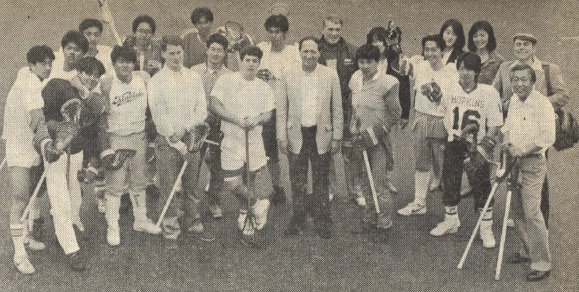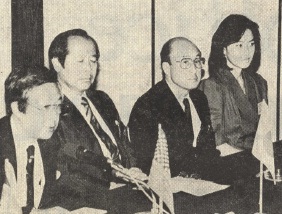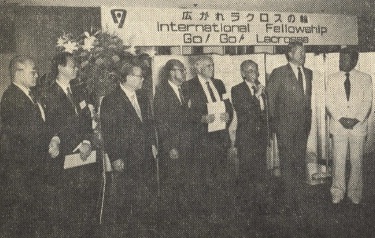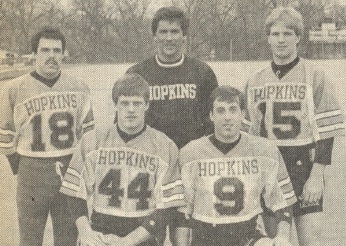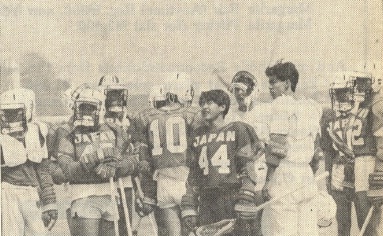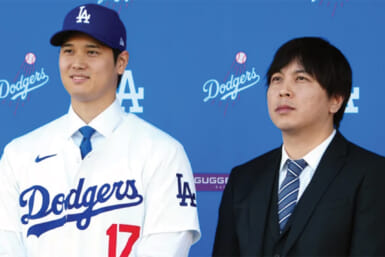LACROSSE — generally considered to be the oldest sport in North America—is making serious inroads in Japan, a sports-loving nation not exactly loathe to embrace foreign ideas, culture and, yes, sporting events. Lacrosse, in fact, can boast of a history which could be meaningful to the Japanese people, steeped as they are in the ancient history of their nation, people and culture. Lacrosse dates its origins back to the 1400s, conceived and perpetuated by the Indian tribes of North America. Legend has it that in its earliest form, Lacrosse was a sacred contest played by various tribes to condition their young braves for combat or to settle tribal disputes.
In recent months, a group of Lacrosse buffs from America have banded together with Japanese athletic officials and interested citizens to establish the Japan Lacrosse Association. Already college Lacrosse clubs have sprung up and in just a week or so, The Johns Hopkins University — one of the prime collegiate Lacrosse groups in the world — will send a group of players and coaches to teach the rudiments and many of the finer points of the game to their eager Japanese counterparts. Included will be three All-American varsity players, their varsity goalie and coach. In this effort, Keio University has formed the vanguard in introducing this native American sport — fast-moving, exciting, at times almost violent in its execution. But the hard-hitting aspects can be down-played, as evidenced in the fact that many women’s teams are competing on a collegiate level in the United States, primarily in the northeast region.
To hasten the introduction, acceptance and eventual wide participation in this dynamic sport, the Japan Lacrosse Association was formed by Americans with Japanese sports enthusiasts quickly joining in. The first steps were taken last September by Norio Endo, a Johns Hopkins graduate and long-term Lacrosse enthusiast, also Director, North Pacific Region, for Grumman International. Endo gathered around him about a year ago, a group of like-minded individuals, gaijin and Japanese alike, determined to introduce the game of Lacrosse to the Japanese public, a public he and his associates were certain would gravitate to the game quickly, since skill, agility, quickness and determination are more requisite to playing the sport than size and bulk.
Joining Endo in the original group were Joe Diele (Senior Vice President, Panmetrics Japan), George Purdy (President, Gemicorp, Ltd.), and Corky Alexander (Editor & Publisher, Tokyo Weekender). As the movement gained momentum, Endo recruited Chiharu (Chick) Igaya (CEO, American Home Assurance Co.) one of the leading members of the International Olympic Committee; Bob Collins (AIA and President of The American Club); Donald (Bud) Rosenthal (IBM Asia Pacific and longtime Lacrosse enthusiast); H. Kimura (President, Kimura Shoji Co., Ltd.); S. Nobu (President, International Machine Co., Ltd.); M. Fujii (Keio University); Ken Nottingham (CEO, AIG Companies, Japan/Korea); Sadao Irie and K. Takahashi (both Senior Partners, Peat Marwick), and S. Tanabe (Division General Manager, Tokyu Agency, Inc.).
The germ for the idea of introducing Lacrosse to Japan originated more than two years ago when Johns Hopkins Vice President Ross Jones came to Tokyo to award Prime Minister Yasuhiro Nakasone an honorary degree. At a reception, he conferred with Endo, a 1956 Johns Hopkins grad. “Wouldn’t it be great,” Jones said to Endo, “if we somehow could promote Lacrosse to the Japanese people, using our school as the focal point.” Although he never was on the college’s Lacrosse team, Endo has always been a big supporter.
That’s all Norio Endo needed; the ball was in his court, so to speak, and he was off and running, establishing the bare bones of his committee, then expanding it and calling on each member’s expertise and promotional and organizational skills.
The next step was the arrival of Johns Hapkins Athletic Director Bob Scott and his wife Margo — accompanied by Lacrosse sticks, arm pads, balls, a video tape, photographs, posters and a portable goal. Scott — formerly the Lacrosse coach at the school — was the perfect man to introduce this ethnic American sport for his enthusiasm and verve are contagious. He demonstrated the game to many student groups during his 10-day stay.
But even so, it was discovered that Scott was not the first Lacrosse disciple to have attempted to introduce the game here. Earlier Marc Edelson, Johns Hopkins School of Advanced International Studies, and Tim Goodal of the University of Chicago were in Tokyo on graduate intern programs. The two Baltimore natives spent time with students at Tokyo and Keio universities teaching the fundamentals of how to catch and throw.
With the arrival of the Johns Hopkins all-star next week, the training sessions are nearing some sort of a climax. The schedule is roughly like this: on July 21, plans are for a preliminary clinic at Yokota Air Base to try to enlist military players. July 22 will feature a demonstration and introduction to the sport at the American Club will the cooperation of Recreation Director Tom Wilkins. July 23-29 will see two-a-day workouts and instructional sessions with Japanese college students. July 31-Aug. 5 — an instructional Lacrosse camp established in the Japan countryside, location not determined at Weekender press time.
Assisting the Johns Hopkins teaching clinic will be Steve Gleason, former captain of the Dartmouth team, and Rob Simpson, Notre Dame goalie. Both are among a group of American businessmen in Tokyo now playing and teaching Lacrosse skills.
A bit of history of the game: Lacrosse was the name given by the French settlers of Canada to the old Indian game of “baggataway,” so called because the implement used — the curved, netted stick — resembled a bishop’s crozier. It is the oldest organized sport in America, played by the Six Nations of the Iroquois throughout the terretory of upper New York State and lower Ontario before Columbus landed in the New World in 1492.
The Iroquois confederation adopted the sport as a training measure for war; it is still played by Indians at government reservations in the U.S. and Canada.
The game was taken up by white men in about 1840. It has become the national summer sport in Canada and is also popular in the British Isles and Australia.
International series have been held periodically with England and Ireland since 1884, and competition has taken place frequently between the U.S. an Canada since 1885.
Women’s Lacrosse was started in England about 1900 and later was introduced in the U.S. by Englishwomen.
Today the game is generally played on a soccer-sized field with 10 players on each side. It’s been called the fastest sport on two feet, to distinguish it from ice hockey which is faster — on skates. Lacrosse is played with a long stick with a net at the end; a very hard ball— about the size of a baseball — is used. The objective is, using only the stick, to throw the ball into the opponent’s net.
The game is very fast-paced with few times out — and can be pretty rough, depending upon the heat of the competition. In many ways, it resembles a combination of soccer, basketball, hockey and American football.
Currently Lacrosse is played at nearly 200 universities in the U.S. and about 500 high schools: both men and women play the game and it’s been termed the fastest-growing sport in America.
Says Norio Endo: “The Japan Lacrosse Association and the United States Lacrosse Foundation believe that through this sport international relations can be further improved by young university sportsmen in developing personal and competitive relations with foreign students. Most people who are familiar with the game of Lacrosse are very sure that the Japanese can be as equals in international competition with top U.S. teams, even though it can be a fairly rough contact sport.
“Unlike football, rugby, soccer, basketball, hockey and volleyball, the skills in throwing, catching and teamwork are usually the determining factors to produce a winning team. Physical size has little bearing. Therefore, it is felt that in Lacrosse Japanese sportsmen have an excellent chance to compete successfully on an international level.”
External Link:
Japan Lacrosse Association

